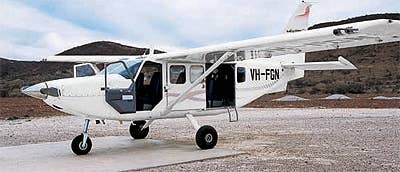
Gippsland GA-8 Airvan
Over time, some very good things have come out of Australia-boomerangs, koala bears, and Fosters Lager, to name a few. And now there's a new addition to that list. This past summer, Gippsland Aeronautics, based in the Latrobe Valley in southeastern Australia, received FAA certification for its GA-8 Airvan-an eight-seat, utility aircraft that was designed for flying in the bush. Or, as the bush is known in Australia, the Outback.
The Airvan was designed to fill a perceived gap between the Cessna 206/207 models and the larger, turbine-powered Cessna 208 Caravan. In fact, the Airvan looks very much like a shrunk-down version of the Caravan, with a boxy, big-window fuselage, but a Lycoming IO-540 piston engine instead of the Caravan's larger, turbine powerplant. But if the airplane's nose also looks a bit familiar to EAA enthusiasts, it might have something to do with the fact that Peter Furlong, who designed the GA-8, was also the first person in Australia to build a Wittman Tailwind.
The Airvan's performance numbers are certainly adequate-even at its maximum takeoff weight of 4,000 pounds (including a useful load of 1,760 pounds), the Airvan has a cruise speed of 125-130 knots, a range of 5.5 hours, takes 1,800 feet to clear a 50-foot obstacle and 1,200 feet to descend and stop from the same altitude, and can have a takeoff ground roll as short as 525 feet. On a "normal sort of day," according to Gippsland demo pilot Gerard Lappin, the Airvan could operate quite happily out of a 1,000-foot strip.
But what's truly impressive about the GA-8 is that it was obviously designed by experienced Outback pilot/mechanics who'd had more than their share of frustration with existing aircraft models. The visibility from the Airvan, for example, is simply wonderful-for both pilots and passengers. The wing is set back a bit from the pilot's door, offering remarkably good up-and-down views, and each of the passengers gets the benefit of a large, rectangular window.
The GA-8's cabin is also big enough to have an aisle in between the seats-a welcome relief from the squished-in feeling that smaller bush aircraft have. And, perhaps even more important for pilots flying passengers in rough, backwoods conditions-the ventilation in the Airvan is superb throughout the entire cabin. If a passenger does get sick, the upholstery and carpet are all assembled in modular sections, to make removal, cleaning or replacement a quick and painless process.
In fact, everything in the Airvan is designed for easy access and maintenance. The seats can be removed simply by slipping four metal, tab-like tools into slots under their legs. And all of the airplane's wiring, control cables and other maintenance-required items have been plumbed along the sides of the aircraft fuselage, where they can be reached through ergonomically designed pop-out panels along the cabin walls. Like I said, this airplane was obviously designed by pilot/ mechanics who'd been there.
The Airvan's larger cabin area means the plane is well equipped to carry bulky cargo loads, as well. The GA-8 has a 42- by 42.5-inch sliding cargo door, and the cabin can easily hold four 55-gallon drums-or, perhaps even more importantly for Australian operators-72 slabs of Victoria Bitter (VB) beer.
In the air, the GA-8 is a stable and straightforward airplane. Coming out of a gravel strip in south-central Australia's Flinders Ranges, we were able to climb at over 1,000 fpm, although the plane did require a surprising amount of right rudder in the climb. It also required a generous spinning of the trim wheel to get the desired response, but once it was trimmed out, it stayed where it was put. Stalls are a non-event, and with full flaps and 60 knots, the Airvan descends gently toward a short-field landing and flares beautifully, without having to pull hard on the yoke.
My biggest complaint with the airplane was the location of its mechanical flap handle, which-due to my need to pull the seat all the way forward to reach the rudder pedals-made it extremely difficult for me to get enough leverage to apply full flaps. However, Gippsland says it's in the process of fixing that. The company is also apparently considering lengthening the GA-8's cabin, increasing its fuel capacity, and perhaps replacing the piston engine with a turbine, but there are no specific dates for any of those mods.
But even the "Mark I" version of the Airvan, which has been in production in Australia since 1999, seems to have found a ready market-both Down Under and abroad. A total of 57 aircraft have been delivered so far, and the U.S. Civil Air Patrol has ordered 15 of the aircraft-which sell for a little more than $500,000US. In Australia, the GA-8 has proven popular with Outback tour operators, who like its spacious cabin and user-friendly design. All the Outback Airvan operators I spoke to gave the airplane a good report card on maintenance, as well.
The Cessna 206 and 207 do a great job for their size. But if the 206 is the station wagon of the bush, then the GA-8 Airvan might realistically be the economy SUV. Not a Ford Excursion-size SUV like the Cessna Caravan, of course, but perhaps something along the lines of an Explorer. Oh, wait. Make that an Isuzu Rodeo or a Honda Passport. After all, the Airvan is an import.
It's always a risky thing to make predictions about relatively new airplanes, of course. But while the Airvan may be a newcomer to the U.S. market, it seems to fill a unique market niche very well. Which means that this particular import might be here to stay.
For more information on the GA-8 Airvan, go to: www.gippsaero.com, or contact Gipps-land Aeronautics at: sales@gippsaero.com.

Subscribe to Our Newsletter
Get the latest FLYING stories delivered directly to your inbox






